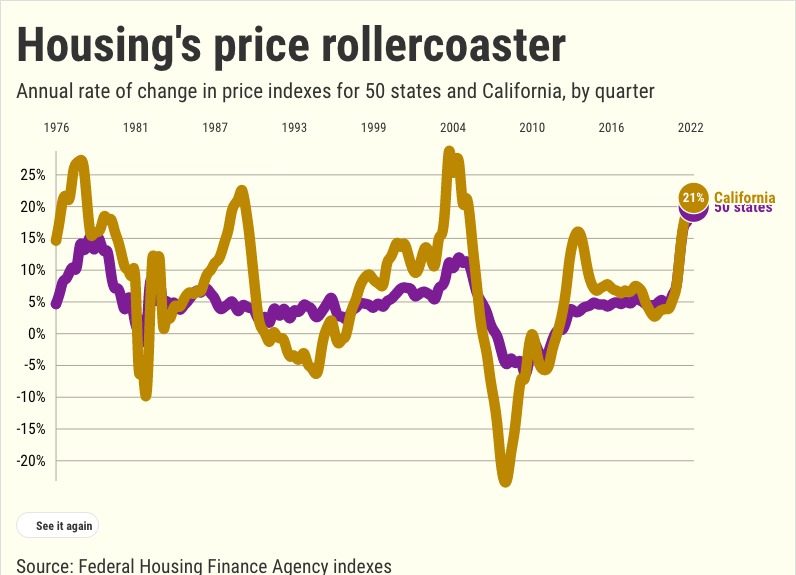
“This is NOT 2008,” say many high-profile real estate gurus of the current homebuying slowdown.
You do remember 2008? Barack Obama was elected president. Swimmer Michael Phelps captured Olympic fame. The No. 1 movie was a Batman tale, “The Dark Knight.”
Oh, and global financial markets imploded after risky mortgages went belly up. The Great Recession ensued. Home prices crashed.
Well, 2022’s soaring mortgage rates and growing economic worries produced stunning drops in housing’s purchasing pace this summer. Sales are indeed as slow as the meltdown of the mid-2000s.
Yet price indexes have yet to show significant weakness amid this year’s icy buying trend. And many analysts are offering “don’t worry” prognostications.
Their rosy scenarios suggest any allusions to a 2008-like crash are off base. Housing’s ugliest period was heavily tied to bad lending decisions. Those kind of mistakes were not made in the pandemic era’s price upswing, the upbeat forecasts say.
How bad was it?
“2008” in real estate chatter isn’t just about one 12-month period. Instead, the year was the pinnacle of a nasty housing market reversal that started in 2007 and saw fallout through 2012.
Let’s take a broader view, looking at price swings in the 50 states dating to 1975. My trusty spreadsheet found that 60% of all losing years in the 47 years of Federal Housing Finance Agency index results occurred in the 2007-12 crash period.
It’s a similar story in California where prices fell in five of the six crash years — but just seven times in the other 40 years.
Next, consider the size of the crash era’s losses — an abrupt change from when that housing bubble was inflating.
Lansner’s mailbag: Housing crash is media’s fault
In California, home prices fell an average 7.8% a year in the 2007-12 crash. That was the third-worst drop among the states and quite a U-turn from the preceding six bubble-building years that saw 15.5%-a-year gains — second-highest in the nation.
Nationwide, the turnabout was not as spectacular as losses averaged 2% a year in the six-year crash vs. 8% annual gain in preceding 2001-06.
History lesson
Well, if 2022 isn’t 2008, then what is it?
So I turned my spreadsheet into a time machine of sorts, axing the six crash years from housing’s history books. Essentially, what do home prices do when they’re not taking an epic flop?
In California, the “non-crash” history shows home prices averaging 9.1% gains, No. 1 among the states. But please note that there were seven down years (No. 3 highest among the states). So price declines — even when the mid-2000s crash is excluded — occurred 18% of the time.
The caveat to many of 2022’s “it’s different this time” forecasts is the chance for regional price drops. Well, the national slice of my “non-crash” history agrees.
The average state had 5.8% annual gains in the 40 “non-crash” years. But that appreciation came with an average three down years — or losses 7% of the time.
In a nutshell, home prices have a habit of occasionally falling — even when it isn’t “2008” all over again.
What’s next?
Virtually anybody who tracks housing agrees that 2022 marks the end of this real estate cycle’s history-making appreciation.
Think about what the FHFA indexes are telling us this year.
California home prices rose at a 21% annual pace in 2022’s first half. It was California’s eighth-highest gain in history and a rate of appreciation triple the 7% increases averaged since 1975.
But this eye-catching jump was only the 16th biggest among the states.
To start 2022, 19 states set new record highs for one-year home-price gains. Yes, larger jumps than increases of the bubble that burst in the mid-2000s.
Also, the 19.3% average increase among the states was the all-time high — and quadruple the 4.8% annual average since 1975.
The grand debate, however, is what future is created by the market’s ongoing normalization/recalibration/correction — or whatever you want to call the brewing cooldown.
Related Articles
LA-Orange County home price index takes 1st dip in 3 years
Bubble watch: Worst time to sell California home in 17 months
Big chill: US homebuying cooldown is intensifying
Orange County homebuying cools 38% after 48% higher house payments
Bubble watch: Half of California homes 10% or more overvalued
Could it be swift and sharp like the early 1980s when, much like today, the Federal Reserve was boosting interest rates to slow an overheated economy?
California’s prices surged at a 19%-a-year clip in 1976-80. Then came a 5.4% loss in 1982. Nationwide, 10% annual gains in 1976-80 cooled to 1.1% in 1982 with price drops in 19 states.
Or could the deceleration be a slow, long chill like the early 1990s when festering economic ills created an extended period of homebuying malaise?
California’s price gains of 12% a year in 1986-90 morphed into 2%-a-year average losses the next five years. Nationwide, it was less dramatic: 5%-a-year appreciation cooled to 3.4% in 1990-94 — but 15 states had at least one down year in the five-year period.
Jonathan Lansner is the business columnist for the Southern California News Group. He can be reached at [email protected]
